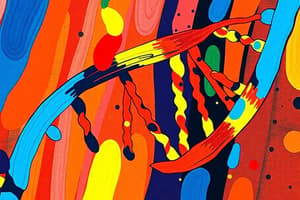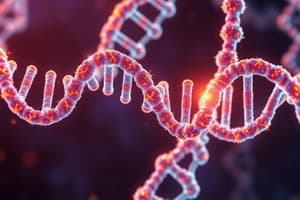Podcast
Questions and Answers
What is the primary process that occurs after DNA replication?
What is the primary process that occurs after DNA replication?
- Transcription (correct)
- Mutation
- Translation
- Replication again
In the context of the central dogma of molecular biology, which of the following correctly represents the flow of genetic information?
In the context of the central dogma of molecular biology, which of the following correctly represents the flow of genetic information?
- RNA → DNA → Protein
- DNA → Protein → RNA
- Protein → DNA → RNA
- DNA → RNA → Protein (correct)
Which type of nucleic acid is produced during the transcription process?
Which type of nucleic acid is produced during the transcription process?
- mRNA (correct)
- DNA
- tRNA
- rRNA
What role does RNA play in the process of translation?
What role does RNA play in the process of translation?
Which of the following statements is true regarding the strands during DNA replication?
Which of the following statements is true regarding the strands during DNA replication?
What type of sugar is found in DNA?
What type of sugar is found in DNA?
Which base pairs with adenine in RNA?
Which base pairs with adenine in RNA?
In which part of the cell does transcription occur?
In which part of the cell does transcription occur?
What is the primary function of messenger RNA (mRNA)?
What is the primary function of messenger RNA (mRNA)?
Which process involves the conversion of mRNA into a functional protein?
Which process involves the conversion of mRNA into a functional protein?
What is the complementary DNA sequence for the strand TAC CCG ATA ATC ATG?
What is the complementary DNA sequence for the strand TAC CCG ATA ATC ATG?
What does the central dogma of molecular biology describe?
What does the central dogma of molecular biology describe?
Which of the following is NOT a type of RNA?
Which of the following is NOT a type of RNA?
Which stage of gene expression directly involves encoding the genetic information from DNA into RNA?
Which stage of gene expression directly involves encoding the genetic information from DNA into RNA?
During RNA processing, which of the following modifications is typically made to mRNA?
During RNA processing, which of the following modifications is typically made to mRNA?
What is the main function of tRNA during translation?
What is the main function of tRNA during translation?
What is synthesized as a direct product of transcription?
What is synthesized as a direct product of transcription?
In translation, which sequence represents the start codon?
In translation, which sequence represents the start codon?
During the translation process, how are amino acids linked together?
During the translation process, how are amino acids linked together?
Which of the following statements about the structure of mRNA is correct?
Which of the following statements about the structure of mRNA is correct?
What does the term 'codon' refer to in the context of translation?
What does the term 'codon' refer to in the context of translation?
What is the end product of translation?
What is the end product of translation?
Which molecule acts as the template for the synthesis of mRNA during transcription?
Which molecule acts as the template for the synthesis of mRNA during transcription?
Flashcards
What is DNA?
What is DNA?
Deoxyribonucleic acid (DNA) is a molecule that carries genetic information in all living organisms. It comprises two complementary strands of nucleotides wound around each other in a double helix structure. Each nucleotide consists of a sugar (deoxyribose), a phosphate group, and one of four nitrogenous bases: adenine (A), thymine (T), guanine (G), and cytosine (C).
What is RNA?
What is RNA?
Ribonucleic acid (RNA) is a single-stranded nucleic acid that plays crucial roles in protein synthesis. It is synthesized from DNA through transcription and carries genetic information from the nucleus to the cytoplasm. There are three main types: messenger RNA (mRNA), transfer RNA (tRNA), and ribosomal RNA (rRNA).
Central Dogma
Central Dogma
The central dogma of molecular biology describes the flow of genetic information within a biological system. It states that DNA is transcribed into RNA, which is then translated into protein.
Replication
Replication
Signup and view all the flashcards
Transcription
Transcription
Signup and view all the flashcards
Translation
Translation
Signup and view all the flashcards
DNA Replication
DNA Replication
Signup and view all the flashcards
Template Strand
Template Strand
Signup and view all the flashcards
Complementary Strand
Complementary Strand
Signup and view all the flashcards
What is Transcription?
What is Transcription?
Signup and view all the flashcards
What is Translation?
What is Translation?
Signup and view all the flashcards
What is Messenger RNA (mRNA)?
What is Messenger RNA (mRNA)?
Signup and view all the flashcards
What is Transfer RNA (tRNA)?
What is Transfer RNA (tRNA)?
Signup and view all the flashcards
What is a Ribosome?
What is a Ribosome?
Signup and view all the flashcards
What is a Codon?
What is a Codon?
Signup and view all the flashcards
What is Transcription?
What is Transcription?
Signup and view all the flashcards
What is RNA Processing?
What is RNA Processing?
Signup and view all the flashcards
Study Notes
DNA and RNA Structure and Function
- DNA and RNA are crucial molecules for life, carrying genetic information and directing protein synthesis.
- DNA is a double-stranded molecule, while RNA is typically single-stranded.
- The building blocks of both DNA and RNA are nucleotides.
- Nucleotides consist of a nitrogenous base, a sugar, and a phosphate group.
- DNA's sugar is deoxyribose, and RNA's sugar is ribose.
- DNA bases are adenine (A), thymine (T), guanine (G), and cytosine (C).
- RNA bases are adenine (A), uracil (U), guanine (G), and cytosine (C).
- DNA forms a double helix structure held together by hydrogen bonds between complementary base pairs (A with T, and G with C).
- RNA typically doesn't form a double helix.
DNA Replication
- DNA replication is the process of creating identical copies of DNA from an original DNA molecule.
- It's crucial for cell division and maintaining genetic information.
- DNA polymerase is the enzyme responsible for building new DNA strands, using the original DNA strands as templates.
Protein Synthesis
- Protein synthesis is a central biological process, where cells convert genetic information into proteins.
- It involves two main steps: transcription and translation.
Transcription
- In transcription, the information in a DNA strand is copied into a messenger RNA (mRNA) molecule.
- This process occurs in the nucleus.
- RNA polymerase is the enzyme that synthesizes mRNA using the DNA template.
- The mRNA molecule then travels to the ribosome in the cytoplasm.
Translation
- In translation, the mRNA molecule's sequence is decoded to assemble a polypeptide chain of amino acids.
- This process occurs in the ribosome in the cytoplasm.
- Transfer RNA (tRNA) molecules carry specific amino acids to the ribosome, matching them to the codons (three-base sequences) on the mRNA.
- The sequence of amino acids in the polypeptide chain determines the protein's structure and function.
Central Dogma
- The central dogma summarizes the flow of genetic information: DNA → RNA → Protein.
- DNA replicates to create identical copies of itself.
- DNA is transcribed into RNA.
- RNA is translated into proteins.
- This process ensures the accurate transfer and expression of genetic information needed for life.
Functions of Proteins
- Many different functions are carried out by proteins.
- Proteins can act as enzymes, catalyzing biochemical reactions.
- They can be structural components, like those in muscles and hair.
- Proteins can serve as hormones & antibodies.
- Some proteins act as channels in cell membranes, controlling molecular movement into and out of the cell.
Studying That Suits You
Use AI to generate personalized quizzes and flashcards to suit your learning preferences.




